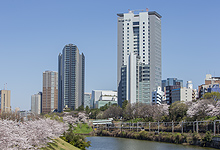A research group from Hosei University and Kyoto University has elucidated the reason for the bright red body color of the wall mite found on concrete walls in early spring.
Despite the fact that many people around the world have questioned why the tick, which has a bright red body, has such a conspicuous red color, it has never been scientifically investigated.
It emerges in early spring, lays eggs during the rainy season, and lays eggs dormant until the following spring, so spring is the center of survival activities.They live in sunny places such as concrete walls, and feed mainly on pollen.For this reason, one of the most important survival challenges is to withstand oxidative stress caused by active oxygen generated in a harsh environment with strong UV rays in early spring and radiant heat reaching over 40 degrees Celsius.
An analysis of the bright red pigments of the genus Kabeana var. mite revealed that it contained large amounts of the antioxidant ketocarotenoids astaxanthin and 3-hydroxyechinenone.In particular, the astaxanthin concentration (334.8 ng/μg protein) is said to be the highest reported value among microarthropods such as crustaceans.Among other mites, the citrus red mite lives on the leaves of plants and is exposed to strong sunlight, so it has been known that it synthesizes and accumulates a large amount of astaxanthin to protect itself from oxidative stress. The astaxanthin concentration was 127 times higher than that of Citrus red mite.
From this, it is thought that the Kabeana takara mite synthesizes antioxidants from the pollen it feeds on and accumulates them in high concentrations to protect its body from ultraviolet rays in early spring, resulting in its red body color.It should be noted that just because it has a flashy red color does not mean that it is easy for natural enemies to spot it.Many of the insects (such as ants) that prey on this tick do not have red photoreceptors and cannot distinguish red, so this is not a concern for humans.


